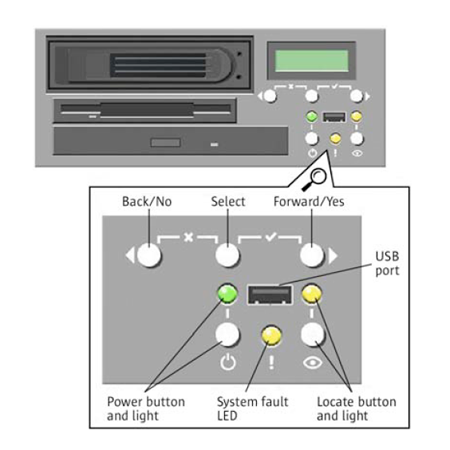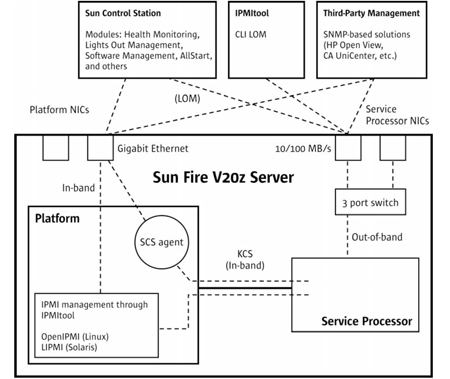Sun Fire V40z: Four Opterons in a 3U
by Kristopher Kubicki on February 22, 2005 12:05 AM EST- Posted in
- Systems
System Management: Another Linux Success
Sun easily separates themselves from whitebox manufacturers with their management capabilities. The fact that Sun chose an embedded Linux platform as the nerve center of their server really only proves to sweeten the pie.The MPC855T PowerPC – or Service Processor (SP) as it’s more commonly called in this analysis – is in fact an entire embedded Linux computer of its own. Even when plugging in one of the managed power supplies, the SP kicks on and boots up. All management of the system is handled through this minicomputer: the serial console, front console, BIOS, fan speeds and even power draw. Even when the machine is off, the SP allows us to manage the status of the system, even if it has crashed, remotely or locally. In a worst case scenario, the SP can actually be rebooted from a hard switch in the rear of the machine.
Fortunately, Sun provided us with another block diagram to explain the inner workings of the Service Processor.
Two 10/100 out-of-band Ethernet ports are routed via a dedicated three-port Ethernet switch solely to the Service Processor. This way, any management Ethernet can actually be daisy-chained to reduce the total number of cables in a rack. IPMI, SNMP or Sun Control Station can all route over this out-of-band (or in-band) network for server status and maintenance. The out-of-band network address of the Service Processor can actually be set via the console in the front of the server, or via DHCP (default). Of course, the traditional serial console is also available for those who need it.
Given the versatility, and since it’s always running, we can actually connect remotely to the SP via SSH and do things like update the BIOS, or perhaps just change some settings in it. This “Lights Out Management” approach is not a new concept, but Sun clearly has the most thorough implementation that we have yet to touch.

Overall, we were incredibly impressed with the thoroughness of Sun’s Service Processor. Anything short of forgetting the BIOS password or replacing hardware will ensure that the system stays up. Considering that most of the tools used inside the SP environment are free and/or open sourced, it only adds further to its desirability as clever administrators could very easily expand on the SP’s original functionality.











38 Comments
View All Comments
RadeonGuy - Tuesday, February 22, 2005 - link
I Wish I Had One*drool*
Ahkorishaan - Tuesday, February 22, 2005 - link
That thing is a monster! I can't even think of something to do with that much power... It would be wasted on anything I throw at it, that's for sure. Good thing I don't have 22,000 to throw away...Viditor - Tuesday, February 22, 2005 - link
Wow...what a machine! I'd read the pathscale record setting previously, but it looks like HP has a real headache here...(Dell isn't even in the game...)Doormat - Tuesday, February 22, 2005 - link
Yea the benchmarks are missing. I'd also like to see some reviews of "cheaper" (by an order of magnitude or so) 1U/2U 1/2-way systems. It'll be interesting to see what happens when dual core goes live later this year. I'd love to get some 1U 2-way servers and stick dual core chips in them. 4 procs in a 1U housing. Yeah. Baby.bersl2 - Tuesday, February 22, 2005 - link
#3: On the contrary. PPC runs embedded all the time.mickyb - Tuesday, February 22, 2005 - link
They don't work for me either. On another note, the PowerPC management board is interesting. I am familiar with the HP Integritry Management Board. I don't think it runs Linux. I wonder if AMD would be interested in making a management board based on the Geode processor. PowerPC seems a bit much.vaystrem - Tuesday, February 22, 2005 - link
Are the database benchmark images not working for anyone else?LeadFrog - Tuesday, February 22, 2005 - link
That is a beast.